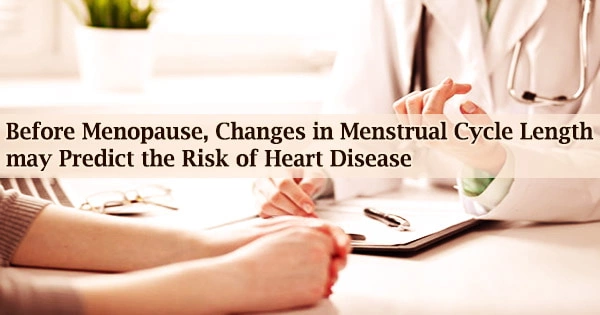The length of a woman’s menstrual cycle often lengthens as she approaches menopause. According to a new study headed by University of Pittsburgh researchers, the timing of these alterations could provide hints about a person’s risk of developing heart disease.
The study, which was published today in Menopausal, looked at how cycle length changed during the menopause transition and discovered that women whose cycle length rose two years before their final menstrual period had better vascular health than those whose cycle length remained unchanged.
Changes in cycle length, when combined with other menopause-related features and health measurements, may help clinicians predict which patients are at higher or lower risk of cardiovascular disease and propose preventative treatments.
“Cardiovascular disease is the No. 1 killer of women, and the risk significantly increases after midlife, which is why we think that menopause could contribute to this disease,” said lead author Samar El Khoudary, Ph.D., associate professor of epidemiology at Pitt’s Graduate School of Public Health.
“Menopause is not just a click of a button. It’s a multistage transition where women experience many changes that could put them at higher risk for cardiovascular disease. Change in cycle length, which is linked to hormone levels, is a simple metric that might tell us who is more at risk.”
A menstrual cycle lasts roughly 28 days on average, however, this varies greatly across women. Long and irregular cycles during reproductive years have been linked to cardiovascular disease, breast cancer, osteoporosis, and other conditions, and those with frequent short cycles spend more time with high estrogen levels than those with fewer long cycles. This variation in hormone levels could explain why long and irregular cycles during reproductive years have been linked to cardiovascular disease, breast cancer, osteoporosis, and other conditions.
El Khoudary and her colleagues questioned if variations in menopausal cycle duration could also predict future cardiovascular health. The researchers used data from 428 individuals in the continuing Study of Women’s Health Across the Nation to answer this question.
These findings are important because they show that we cannot treat women as one group: Women have different menstrual cycle trajectories over the menopause transition, and this trajectory seems to be a marker of vascular health. This information adds to the toolkit that we are developing for clinicians who care for women in midlife to assess cardiovascular disease risk and brings us closer to personalizing prevention strategies.
Samar El Khoudary
The women in the study were 45 to 52 years old at the time of recruitment and were followed for up to ten years or until they were postmenopausal. The researchers gathered menstrual cycle data throughout the menopausal transition and used arterial stiffness or artery thickness to determine cardiovascular risk after menopause.
During the menopause transition, the researchers discovered three unique paths in menstrual cycle duration. Roughly 62 percent of participants had stable periods that didn’t alter much before menopause, whereas about 16 percent and 22 percent had an early or late rise, defined as a five-year or two-year increase in cycle duration before menopause, respectively.
Women in the late rise group had considerably better assessments of arterial hardness and thickness than women with stable cycles, indicating a lower risk of cardiovascular disease. The arterial health of women in the early increase group was the worst.
“These findings are important because they show that we cannot treat women as one group: Women have different menstrual cycle trajectories over the menopause transition, and this trajectory seems to be a marker of vascular health,” said El Khoudary.
“This information adds to the toolkit that we are developing for clinicians who care for women in midlife to assess cardiovascular disease risk and brings us closer to personalizing prevention strategies.”
The researchers believe that during menopause, menstrual cycle trajectories reflect hormone levels, which in turn affect cardiovascular health. They intend to study hormone changes in the future to test this theory. According to El Khoudary, it’s unclear why people with stable cycles had a higher risk of cardiovascular disease than those with late increases.
Although studies suggest that elevated estrogen protects the heart in young women with short periods, this hormone may be less beneficial as people get older. El Khoudary also wants to see if menstrual cycle patterns are linked to other cardiovascular risk factors including abdominal fat, which she discovered to be linked to heart disease risk in menopausal women earlier.





